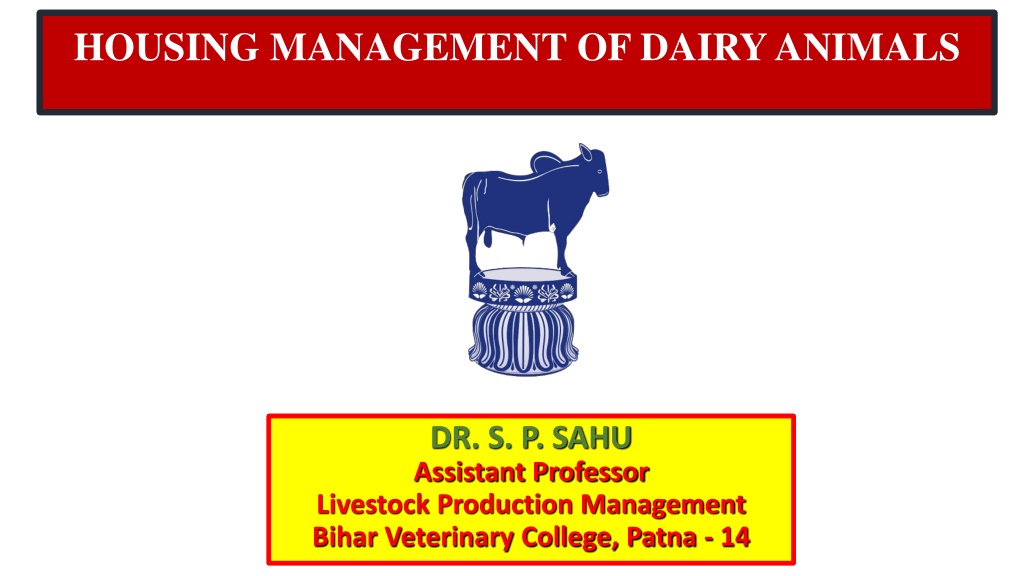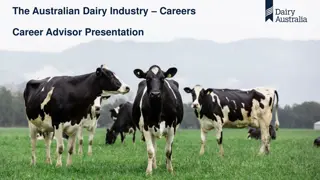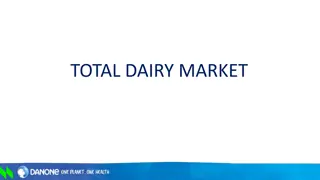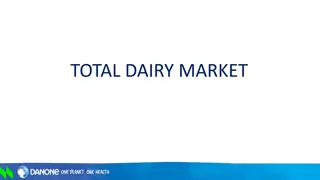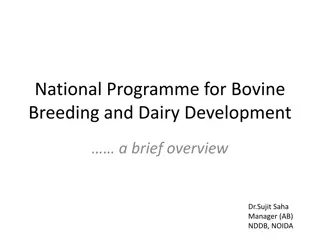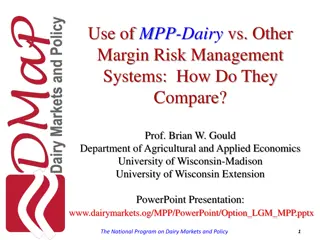Housing Management of Dairy Animals: Objectives, Advantages, and Systems
The housing management of dairy animals is crucial to protect them from inclement weather, ensure maximum production, and safeguard against theft. Adequate housing leads to increased milk production, better health of animals, and improved reproductive efficiency. Selection of the dairy farm site is essential, with considerations for drainage, sun exposure, wind protection, and access to resources. Three main housing systems include loose housing, conventional barn, and free-range systems, with loose housing being more suitable for Indian conditions.
Download Presentation

Please find below an Image/Link to download the presentation.
The content on the website is provided AS IS for your information and personal use only. It may not be sold, licensed, or shared on other websites without obtaining consent from the author. Download presentation by click this link. If you encounter any issues during the download, it is possible that the publisher has removed the file from their server.
E N D
Presentation Transcript
HOUSING MANAGEMENT OF DAIRY ANIMALS DR. S. P. SAHU Assistant Professor Livestock Production Management Bihar Veterinary College, Patna - 14
HOUSING MANAGEMENT OF DAIRY ANIMALS Objectives: To protect animals from sun burns, rain, hot and cold winds of the inclement weather. To provide clean and comfortable shelter for maximum production. Providing better accommodation at a cheaper cost. To protect animals from wild animals and theft.
Advantages of Adequate Housing: 1. Increased production of milk. 2. Better utilization of labour. 3. Production of higher quality milk and milk products. 4. Better health of animals. 5. Decrease in mortality rate of claves. 6. Proper disease control. 7. Better care and supervision of animals. 8. Better productive and reproductive efficiency of animals. 9. Proper and controlled feeding of animals.
Selection of site of dairy farm: Dairy building: At a higher elevation than the surrounding ground to offer a good slope for rainfall and drainage for the wastes of farm. Located to a maximum exposure to the sun in the north and minimum exposure to the sun in the south. Provide protection from prevailing strong wind currents whether hot or cold. Easy accessibility to the farm buildings. Always attractive when the buildings open up to a scenic view and add to the grandeur of the scenery. Abundant supply of fresh, clean and soft water at a cheap rate. Honest, economic and regular supply of labour. Nearby the markets to sell his products profitably and regularly. Adequate supply of electricity. Connected to all weather road.
SYSTEMS OF HOUSING 3 systems: (1) Loose housing system (2) Conventional barn system (3) Free range system Type of housing systems selection depending upon - Geographical and local conditions - Economic condition of the farmers Loose housing system is more suitable to Indian conditions.
LOOSE HOUSING SYSTEM Animals kept loose in an open paddock throughout the day and night except at milking time. Open paddock provided with shelter along one side for animals to stay during hot or cold or rains. Open paddock is enclosed by half walls and fences of suitable height. Common watering tank and feeding manger provided within the shed. Concentrates fed at time of milking in a separate milking barn. Suitable to most parts of the country except in temperate Himalayan region and heavy rainfall areas.
Advantages of loose housing system Cheaper to construct, easier to expand and flexible in utility. Feeding and management of stock is easier due to common feeding and watering arrangement. Animals are more comfortable as they move about freely. At least 10 to 15 percent more stock than the standard can be accommodated for shorter periods without unduly affecting their performance. Detection of heat in animals is easier. Animals also get sufficient exercise which is extremely important for better health production.
Disadvantages of Loose housing system More floor space requirement Competition for feed and fodder among animals Individual animal attention is not possible Provision for a separate milking barn is needed Not suitable in heavy rainfall and temperate areas
CONVENTIONAL/STANCHION BARN SYSTEM Animals in this system are confined on a plat-form and secured at neck by stanchions or neck chains. Animals are more protected from adverse climatic conditions. Animals are fed with fodders, concentrate and milked in the same barn. Completely roofed and walls are also complete with windows/ventilators at suitable places. Most suitable for temperate Himalayan regions due to prolonged and severe winter. Comparatively costly.
Advantages of conventional barn system Less exposure to harsh weather conditions. Animals kept cleaner and better disease control. No need of a separate milking parlour. Disadvantages High construction cost of shed compared to loose housing system. Not suitable to hot and humid climates. Not possible for future expansion of shed.
FREE RANGE/RANCH SYSTEM Leaving the animals free in a large estate. Atype of stock management rather than a type of housing. Natural/cultivated pasture land with watering points and shelter located at convenient places. Suitable for the animals not handled daily. Quite common in southern parts ofAmerica andAustralia. In India, sheep rearing in North Western arid parts and hilly region.
Floor space requirements for different types of animals under LHS Types of animal Floor space requirement(m2) Maximum number Height of the of animals/ pen shed (cm) Covered area Open area Cattle and Buffaloes Bulls 12.0 24.0 1 175 cm in medium and Cows 3.5 7.0 50 heavy rainfall Buffaloes 4.0 8.0 50 and 220 in dry Down-calves 12.0 12.0 1 areas Young- calves 1.0 2.0 30
Feeding and Watering Space Requirements Free access and sufficient feeding/watering space must be allocated without competition. Feeding through/manger must accommodate all the animals at a time. Water through must accommodate at least 10% of the stock at a time. Type of animal Space/anim Total manger length in a Total water tank al (cm) pen for 100 animals (cm) length per 100 animals (cm) 600-750 Adult cattle and 60-75 6000-7500 buffaloes Calves 40-50 4000-5000 400-500
Buildings for Dairy Animals 1. Essential buildings 2.Ancillary buildings 1. Essential buildings Milking barn Fully covered barn used only for milking and located at central place of all buildings. Length: 1.5 to 1.7 meters and Width: 1.05 to 1.2 meters. Width of central passage: 1.5 to 1.8 meters. Two continuous feed mangers on either side of shed with a 0.75 meter wide feeding alley beyond each manger. A shallow U shaped drain of 20 cm wide located on either side of central passage. The eaves of roof should be at least 50 cm away from side walls.
Milch/ Dry animal sheds For housing milch cows and dry cows separately. Simple sheds with a closed area and adjoining open paddock. Covered area: Cement concrete. Open paddock floor: Brick on edge or morum. Calving pens Pregnant animals are transferred to maternity pens 2-3weeks before date of calving. Number of maternity pens required: 5% of number of breedable stock. Dimensions of covered area: 3x4 m. Dimension of open paddock: 3x4 m.
Calf sheds Constructed nearer to the milking barn. Dimensions of calf sheds depend on the number of calves to be housed. Calves of different age groups housed separately for better feeding and management Young stock shed Calves from 6 months to 1 year of age housed separately from suckling calves. Bull shed Located towards one side of farm. Covered area of 3 x 4 m, with an open paddock 120 Sq. m. One bull is required for every 50 breedable cows for natural service.
2. Ancillary buildings Feed stores Used for storing concentrates. 1 concentrate-cum- feed mixing room at a distant place and 1 small feed ration room near the milking barn. Damp free and rodent proof. Size of store: 0.2 m. storage space per adult unit. Silos: Trench silos for Indian conditions. Constructed by excavation in the hard ground and floor and sides are lined with cement concrete. Hay/Straw shed Shed with walls on three sides. Away from animal sheds due to fire hazards.
